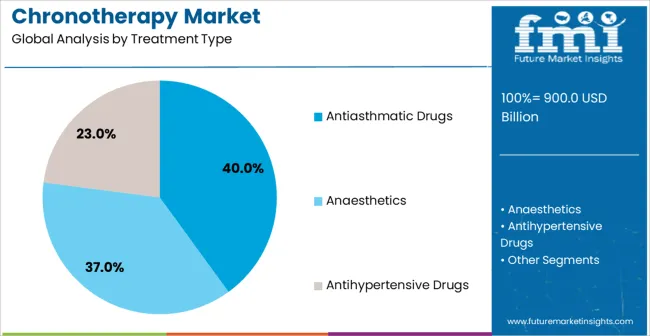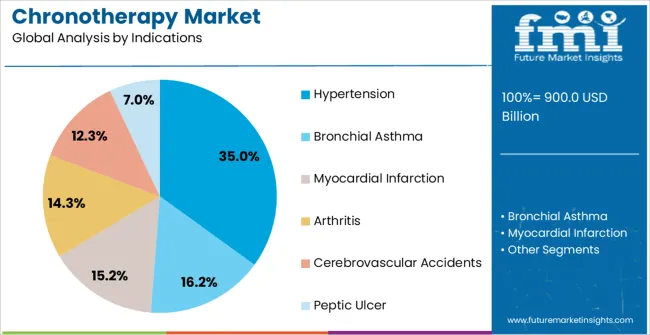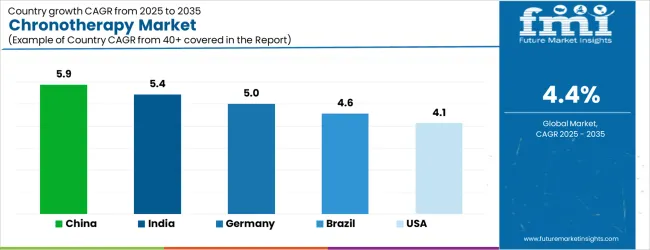The Chronotherapy Market is estimated to be valued at USD 900.0 billion in 2025 and is projected to reach USD 1377.7 billion by 2035, registering a compound annual growth rate (CAGR) of 4.4% over the forecast period.

| Metric | Value |
|---|---|
| Chronotherapy Market Estimated Value in (2025 E) | USD 900.0 billion |
| Chronotherapy Market Forecast Value in (2035 F) | USD 1377.7 billion |
| Forecast CAGR (2025 to 2035) | 4.4% |
The Chronotherapy market is experiencing steady growth due to its focus on aligning treatment schedules with the body’s circadian rhythms to enhance therapeutic efficacy and reduce adverse effects. The market is being driven by the increasing prevalence of chronic diseases such as hypertension and asthma, coupled with growing awareness of circadian biology among healthcare providers and patients.
The adoption of chronotherapy is further supported by advancements in drug formulation and delivery systems that allow timed release of medications. Investments in healthcare infrastructure and rising patient preference for personalized treatment schedules have also contributed to market expansion.
The market outlook is expected to remain positive, with innovations in digital health technologies, including smart pill dispensers and wearable devices, enabling more precise timing of medication administration The combination of clinical benefits, improved patient compliance, and the growing emphasis on precision medicine is anticipated to create long-term opportunities for the Chronotherapy market across both developed and emerging regions.
The chronotherapy market is segmented by treatment type, indications, distribution channel, and geographic regions. By treatment type, chronotherapy market is divided into Antiasthmatic Drugs, Anaesthetics, and Antihypertensive Drugs. In terms of indications, chronotherapy market is classified into Hypertension, Bronchial Asthma, Myocardial Infarction, Arthritis, Cerebrovascular Accidents, and Peptic Ulcer. Based on distribution channel, chronotherapy market is segmented into Hospitals Pharmacies, Retail Stores, and E-Commerce. Regionally, the chronotherapy industry is classified into North America, Latin America, Western Europe, Eastern Europe, Balkan & Baltic Countries, Russia & Belarus, Central Asia, East Asia, South Asia & Pacific, and the Middle East & Africa.

The Antiasthmatic Drugs treatment type is projected to hold 40.00% of the Chronotherapy market revenue share in 2025, establishing it as the leading treatment segment. This dominance is being driven by the prevalence of respiratory disorders and the critical need for medication timing to manage nocturnal symptoms effectively.
Antiasthmatic drugs have been increasingly administered in accordance with circadian patterns, which enhances therapeutic outcomes and reduces side effects associated with conventional dosing. The segment has benefited from the development of long-acting formulations and time-release inhalers that align with peak symptom periods.
Hospitals and clinics are prioritizing the use of chronotherapeutic antiasthmatic drugs for patients with severe or poorly controlled asthma, which has reinforced adoption The growth of this segment is expected to continue as healthcare providers increasingly recognize the value of personalized dosing schedules and the advantages of reducing nighttime exacerbations, ultimately improving patient quality of life and adherence to treatment.

The Hypertension indication segment is anticipated to account for 35.00% of the Chronotherapy market revenue in 2025, positioning it as the leading indication area. The segment’s growth is being attributed to the well-documented benefits of aligning antihypertensive drug administration with circadian blood pressure patterns, which reduces the risk of cardiovascular events and improves long-term patient outcomes. Chronotherapeutic approaches allow medications to be timed to target early morning surges in blood pressure, a period associated with heightened risk of heart attack and stroke.
The adoption of these approaches has been reinforced by clinical guidelines highlighting the importance of timing in hypertension management. Additionally, the rising prevalence of hypertension globally and increasing patient awareness of treatment optimization have supported segment growth.
Hospitals and clinics are actively implementing chronotherapy protocols, and the availability of patient monitoring technologies further facilitates adherence Continued emphasis on patient-specific treatment schedules is expected to sustain growth in this segment over the coming decade.

The Hospitals Pharmacies distribution channel is projected to hold 45.00% of the Chronotherapy market revenue in 2025, making it the largest channel for chronotherapeutic medications. This leading position is being driven by the trusted role of hospitals and pharmacies in dispensing precise dosing regimens and providing guidance on timed medication administration.
The segment has benefited from established infrastructure, direct patient engagement, and the ability to educate patients on the critical importance of adherence to circadian-based dosing schedules. Hospitals, in particular, facilitate controlled medication administration for inpatients, enabling optimal timing and monitoring, while pharmacies support outpatient adherence through counseling and follow-up.
The growth of this distribution channel is also supported by partnerships between pharmaceutical companies and healthcare facilities to introduce timed-release formulations and patient support programs As awareness of the benefits of chronotherapy continues to expand, hospitals and pharmacies are expected to maintain a dominant role in ensuring accurate delivery, adherence, and effective treatment outcomes across patient populations.
Chronotherapy is the treatment method in which availability of drugs tunes to the body clock. Certain plants show rhythmicity by opening at day time and close during the night in the same way human body also behaves and gets affected with the dosage of drugs.
The toxicity and efficacy of many drugs depend upon the behavioral and physiological processes and dosing schedule. Many drugs cause alterations which further leads to altered homeostatic regulation and illness.
Various hormones are released during the day time while some other are released during the night. Diseases such as hypertension, arthritis, asthma follow circadian rhythm. For example, in case of rheumatoid arthritis the pain increases in the morning and reduces as the day ends.
In the case of hypertension, the systolic blood's pressure rises up after 4-6 hours of the patient wakes in the morning and decrease during the afternoon and reaches the minimum at night. Chronotherapy refers to therapeutics which match the rhythms of the disorder and help in optimizing outcomes with minimum side effects.
The therapy targets on releasing of a drug at an appropriate time and at a specific site in order to maintain steady blood levels of a particular drug. The success of the chronotherapy depends on the time at which the medicine is administered by the patient. The Chronotherapy is expected to be promising in future in diseases such as asthma, cardiovascular diseases, and deficit syndromes in children.

| Country | CAGR |
|---|---|
| China | 5.9% |
| India | 5.4% |
| Germany | 5.0% |
| Brazil | 4.6% |
| USA | 4.1% |
| UK | 3.7% |
| Japan | 3.3% |
The Chronotherapy Market is expected to register a CAGR of 4.4% during the forecast period, exhibiting varied country level momentum. China leads with the highest CAGR of 5.9%, followed by India at 5.4%. Developed markets such as Germany, France, and the UK continue to expand steadily, while the USA is likely to grow at consistent rates. Japan posts the lowest CAGR at 3.3%, yet still underscores a broadly positive trajectory for the global Chronotherapy Market. In 2024, Germany held a dominant revenue in the Western Europe market and is expected to grow with a CAGR of 5.0%. The USA Chronotherapy Market is estimated to be valued at USD 307.1 billion in 2025 and is anticipated to reach a valuation of USD 307.1 billion by 2035. Sales are projected to rise at a CAGR of 0.0% over the forecast period between 2025 and 2035. While Japan and South Korea markets are estimated to be valued at USD 43.6 billion and USD 30.4 billion respectively in 2025.

| Item | Value |
|---|---|
| Quantitative Units | USD 900.0 Billion |
| Treatment Type | Antiasthmatic Drugs, Anaesthetics, and Antihypertensive Drugs |
| Indications | Hypertension, Bronchial Asthma, Myocardial Infarction, Arthritis, Cerebrovascular Accidents, and Peptic Ulcer |
| Distribution Channel | Hospitals Pharmacies, Retail Stores, and E-Commerce |
| Regions Covered | North America, Europe, Asia-Pacific, Latin America, Middle East & Africa |
| Country Covered | United States, Canada, Germany, France, United Kingdom, China, Japan, India, Brazil, South Africa |
| Key Companies Profiled | Koninklijke Philips N.V., Vyaire Medical, Verilux, Inc., Zepter International, Medtronic plc, Teva Pharmaceutical Industries Ltd., ResMed Inc., and Beurer GmbH |
The global chronotherapy market is estimated to be valued at USD 900.0 billion in 2025.
The market size for the chronotherapy market is projected to reach USD 1,377.7 billion by 2035.
The chronotherapy market is expected to grow at a 4.4% CAGR between 2025 and 2035.
The key product types in chronotherapy market are antiasthmatic drugs, anaesthetics and antihypertensive drugs.
In terms of indications, hypertension segment to command 35.0% share in the chronotherapy market in 2025.






Full Research Suite comprises of:
Market outlook & trends analysis
Interviews & case studies
Strategic recommendations
Vendor profiles & capabilities analysis
5-year forecasts
8 regions and 60+ country-level data splits
Market segment data splits
12 months of continuous data updates
DELIVERED AS:
PDF EXCEL ONLINE

Thank you!
You will receive an email from our Business Development Manager. Please be sure to check your SPAM/JUNK folder too.
Chat With
MaRIA